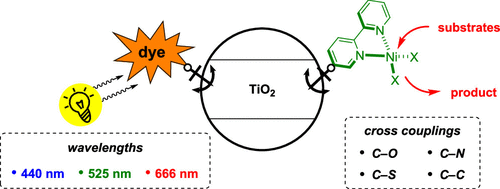当前位置:
X-MOL 学术
›
ACS Catal.
›
论文详情
Our official English website, www.x-mol.net, welcomes your
feedback! (Note: you will need to create a separate account there.)
Modular, Self-Assembling Metallaphotocatalyst for Cross-Couplings Using the Full Visible-Light Spectrum
ACS Catalysis ( IF 11.3 ) Pub Date : 2020-11-02 , DOI: 10.1021/acscatal.0c03950 Susanne Reischauer 1, 2 , Volker Strauss 3 , Bartholomäus Pieber 1
ACS Catalysis ( IF 11.3 ) Pub Date : 2020-11-02 , DOI: 10.1021/acscatal.0c03950 Susanne Reischauer 1, 2 , Volker Strauss 3 , Bartholomäus Pieber 1
Affiliation

|
The combination of nickel and photocatalysis has unlocked a variety of cross-couplings. These protocols rely on a few photocatalysts that can only convert a small portion of visible light (<500 nm) into chemical energy. The high-energy photons that excite the photocatalyst can result in unwanted side reactions. Dyes that absorb a much broader spectrum of light are not applicable because of their short-lived singlet excited states. Here, we describe a self-assembling catalyst system that overcomes this limitation. Immobilization of a nickel catalyst on dye-sensitized titanium dioxide results in a material that catalyzes carbon–heteroatom and carbon–carbon bond formations. The modular approach of dye-sensitized metallaphotocatalysts accesses the entire visible light spectrum and allows tackling selectivity issues resulting from low wavelengths strategically. The concept overcomes current limitations of metallaphotocatalysis by unlocking the potential of dyes that were previously unsuitable.
中文翻译:

模块化的自组装金属光催化剂,用于使用全可见光谱的交叉偶联
镍和光催化的结合已经解锁了多种交叉偶联。这些协议依赖于仅能将一小部分可见光(<500 nm)转换为化学能的光催化剂。激发光催化剂的高能光子会导致有害的副反应。吸收更广光谱的染料不适用,因为它们的单线态激发态很短。在这里,我们描述了克服这种限制的自组装催化剂体系。将镍催化剂固定在染料敏化的二氧化钛上可产生催化碳-杂原子和碳-碳键形成的材料。染料敏化金属光催化剂的模块化方法可以访问整个可见光谱,并可以从战略上解决由低波长导致的选择性问题。通过释放以前不合适的染料的潜力,该概念克服了金属光催化技术的当前局限性。
更新日期:2020-11-21
中文翻译:

模块化的自组装金属光催化剂,用于使用全可见光谱的交叉偶联
镍和光催化的结合已经解锁了多种交叉偶联。这些协议依赖于仅能将一小部分可见光(<500 nm)转换为化学能的光催化剂。激发光催化剂的高能光子会导致有害的副反应。吸收更广光谱的染料不适用,因为它们的单线态激发态很短。在这里,我们描述了克服这种限制的自组装催化剂体系。将镍催化剂固定在染料敏化的二氧化钛上可产生催化碳-杂原子和碳-碳键形成的材料。染料敏化金属光催化剂的模块化方法可以访问整个可见光谱,并可以从战略上解决由低波长导致的选择性问题。通过释放以前不合适的染料的潜力,该概念克服了金属光催化技术的当前局限性。









































 京公网安备 11010802027423号
京公网安备 11010802027423号